#zero wast
Text
I think we a group need to consider what the early “zero waste” movement did in the 2010s. You know. They’d keep “all” their waste in a glass jar, live in a nice apartment somewhere in LA where they had easy access to a refill store and didn’t stop to consider that just existing in the US creates waste they couldn’t see.
I remember watching a video in 9th grade (around 2013) about a chick who did that and even then I was like “that’s bullshit” and it really turned me off the zero waste movement.
The inherent classism of a lot of zero waste purists created a wall between me and them, where instead of them admitting their privilege, they simply said “anyone can do this”. Most people can’t. A zero waste refill store does not exist in my state! Sure, I could try online but this is 1. More expensive- something my dirt poor family could not do at the time and 2. Creates more carbon emissions!
This isn’t to say zero waste is bad- it’s simply a standard most Americans can’t reach. I think this is why I’m so drawn to solarpunk, because I think solarpunk recognizes the classism that is in a lot of eco-friendly products and movements (something I do think is being addressed- I’ve seen more affordable products now than I did in high school). Solarpunk includes diy- reusing packaging that many of us still have to buy because we can’t afford the eco-friendly version.
Idk I just had some thoughts
4K notes
·
View notes
Text
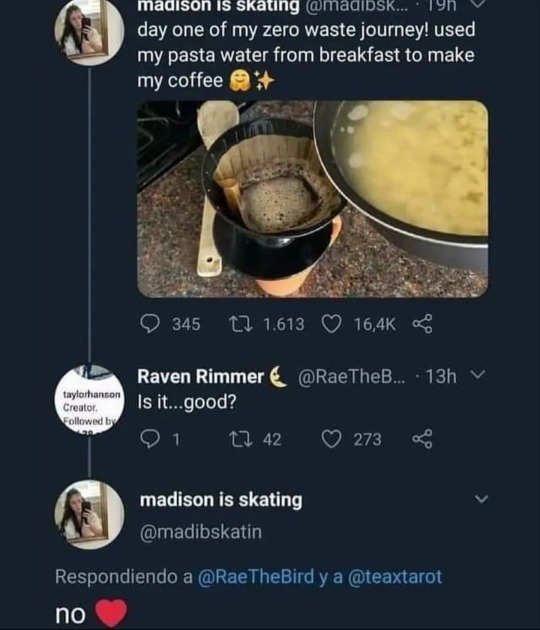
no ❤
11K notes
·
View notes
Text
Anti capitalistic methods of self reliance!
Everyday items:
Plastic bags can be replaced by cloth bags you can sew, without any prior knowledge of sewing, from any old shirt you were going to throw away
Toilet paper can partly or completely be replaced by 'Family cloth', which is a series of cloth napkins cut to the size you like, which are then washed after each use! There's no risk of disease if only used for number one, for number two they need to be submerged into peroxide liquid in order to be safely cleaned. Even if you only use them for number one to stay safe, being reusable and costing nothing they will save you a lot in not having to buy toilet paper
Paper towels can be replaced by little cut-out cloths you can easily wash after use, or a simple kitchen and bathroom cloth for cleaning
Paper tissues have originally been handkerchiefs, washable and reusable, zero waste option (and they can be very pretty too!)
Laundry detergent can be replaced by horse chestnuts, or conkers! If cut open and submerged in water, they will produce soapy water, which is equally good at cleaning as your laundry detergent, completely environmentally friendly and free if you foraged the chestnuts. They can be collected and dried to use for the entire year, and you can tie them up in a sock to put in your washing machine.
Cleaning products can be replaced by vinegar, and if you hate the smell you can change it by infusing citrus peels in it! It will smell like oranges and lemons after you leave them in there for a few weeks
Cleaning products can also be self-made, by fermenting food scraps, it's called 'enzyme cleaner' and it can clean most of things in a completely environmentally friendly way!
Shampoo can be self-made, or replaced with options like herbal teas, which will also ensure that your hair no longer gets greasy, as grease is the result of using shampoo
Menstrual pads can be sown from any discarded pieces of cloth, they only need to be submerged in cold water after use in order for blood to wash out. Additionally you can make washable menstrual panties, which make sure your pads don't move in there!
Simple medicine for aches like stomach cramps, headaches, anxiety, sore throat can be found in the basic knowledge of herbalism, and simply making teas from herbs that soothe these issues. They will not be able to cure a heavy disease, but are able to provide momentary relief from annoying aches!
Immunity booster syrup can be made out of elderberries, if you're careful about not getting any seeds or stems in!
if you're growing food, you can grow your own dish sponges, and washing sponges, the plant is called 'Loofah' and you can grow a whole lot in one season then use them for years
Reuse plastic items for as long as you can, to lessen the amount being thrown into landfills, and if you need new items, aim to get a not-plastic one
If you have lots of paper trash or newspapers, you can learn to make baskets from it.
Instead of throwing away food scraps, you can try setting up a simple composting bin and also get some valuable free soil, that is great for growing little plants and herbs in it
If you're composting on a big scale, the heat compost produces can be used to heat a room
getting into hobbies like soap making, pottery, woodcarving, sewing, knitting or weaving can also save you a lot of purchasing because you realize you can simply make that thing yourself, and in better quality than it would be available at the store
Saving water and energy:
Accumulating water in a big pot while you're washing dishes, then using that water to water your houseplants is safe, especially if you're not using a lot of detergent, and it saves a lot of water
To save energy when cooking in a pot in the stove, wait until your pot starts boiling, then take it off the stove, and wrap it in a cloth, then a towel, then a blanket, and leave it wrapped up. The layers of cloth are making it difficult for the heat to escape the pot, ensuring it will keep very high temperature for half an hour, cooking as if it was on the stove. If it needs to cook longer, you can just put in on the stove for a minute to get it back to boil. You can cook pasta, rice, beans, potatoes, soups, stews, risotto, pretty much anything with long cooking time like this.
If your water boiler is big, you don't need to leave it on at all times, I've reduced my electricity bills by a lot by turning it on only when I intend to use the hot water. In the summer, if you have access to a natural body of water, use that for washing!
If you own a property, watch where the water is naturally going and accumulating; you can collec t this water and set up a system to use it for gardening/any outdoor use
if you're building a structure, making sure that the sun hits the windows in the winter, and that the place is protected from the wind by growing trees as a wind shield, will save loads of energy in heating and cooling it, as well as making sure the structure is well insulated
Heat/cool only the parts of the structure/house that you're using, making it both environmentally friendly and ensuring you don't have a too big temperature difference when you go outside, making you healthier
Try an experiment were you go a day without electricity and see what you can use as alternative in this situation; it's okay if you fail, it will provide you with knowledge of how dependant you are on the energy, and the ideas of what you can possibly do when without!
Clothing:
If sewing clothing from scratch is something that appeals to you, that is ideal for self-reliance! It is likely that after just a bit of practice, you'll be able to sew more quality items than are sold, because current fashion items are made to fall apart, and you can make your clothing strong and durable.
Sharing clothing you no longer want to wear, and letting others know they can offer their unwanted pieces to you can provide you not only with practical clothing, but you can use all fabric, buttons, zippers and other materials to sew! You can, again with minimal practice and even by hand-sewing, make your own bags, tablecloths, placemats, pillows, blankets, decorations, hats and scarfs
Visible mending, embroidering, adding details or creating your own little alterations on clothing will not only provide a sense of accomplishment, but enrich your life in the way of skill development and being able to make and mend things with little resources
Learning about history of textiles and what fast fashion is doing to the environment provides appreciation and love for sewing and creating textiles, and could inspire you to try and see how it feels to do!
Any piece of clothing that is no longer fit to be remade into something new, can still be cut into pieces and used for cleaning, as a paper towel replacement, for wiping the floor or wiping your shoes, and if it's soft, for pillow filling!
For extra clothing or furniture, you can join online groups named 'buy nothing' and 'sharing is caring', where people will often gift extra clothes and furniture for free, sometime appliances and electronics too
Food:
If any outside space is available, learning to garden is an excellent investment in food security
Seeds can be harvested from plants you already have, gifted from neighbour or friend gardeners, and some can even be taken out of store-bought produce
Soil can be taken from the forest ground which has composted leaves as topsoil, dig under a tree for best results
If no outside space is availabe, dwarf plants, herbs, and greens can be grown in containers, clean your air while they also provide food
Learning to forage for wild edible plants will provide both entertainment and free food! Any wild plant you find is likely to be more rich in nutrients than a cultivated plant, making your diet well rounded and healthy
Learning to grow trees and care for them will provide free food not only for you, but for generations to come, as well as offset the damage from the climate change. Knowing how trees work and how to prune and nourish them is powerful knowledge.
Preserving food:
Ways of preserving your food long-term are curing (for onions, potatoes, garlic, pumpkins), canning (tomatoes, peppers, fruit), fermenting (cabbage, hot peppers, turnips), dehydrating and sun-drying (tomatoes, fruit, herbs, hot peppers, mushrooms)
Growing and collecting food during warm months and then saving them for winter was done by people for centuries and it provides a safe and reliable access to food all year round
Buying cheap produce when it's in-season and preserving it can save you a lot of money and bring you far in self-reliance
Making your own recipes and then getting to eat them later in the season bring a sense of accomplishment and pride, as well as providing a zero waste food option
Cooking food from scratch is made easier by having some of your food preserved, because a lot of the time you've already prepaired most of your ingredients, and only have to place them in the pot
If you already know to make your own bread, you can also try making your own yeast, by mixing flour and water, and letting it ferment while adding more flour and water every day. It can last forever.
If you're interested in knowing more about gardening, herbalism, tree care, and foraging, check the 'Homesteading Survival Knowledge' masterlist, filled with links on these specific topics!
These are not ideas that anyone should quickly or immediately integrate in their life; instead, trying whatever seems interesting and appealing, slowly learning about it and trying one thing at the time is more encouraging and sustainable! I myself have spent years learning and integrating these, enabling me to feel happy and confident doing any and all of this. If this is overwhelming, pick whatever feels appealing and do only that! Forget the rest until it feels easy and fun thing to try out.
#anti capitalism#homesteading#self reliance#permaculture#alternatives to capitalism#growing food#environment#zero waste
436 notes
·
View notes
Text

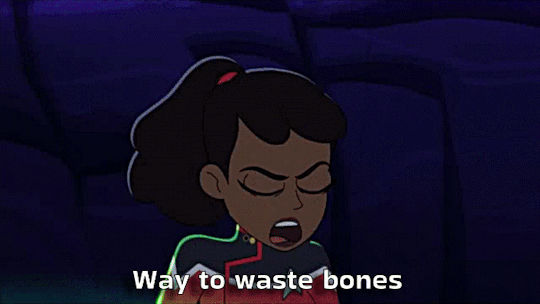
You know who wouldn't have wasted bones?
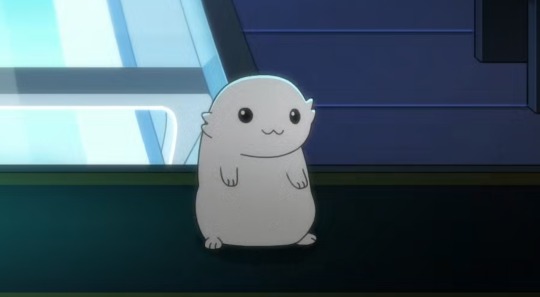
#together the moss and the Moopsy are a zero waste dream team#lwd#star trek lwd#st: lwd#lower decks#star trek: lower decks#lower decks spoilers#lwd spoilers#moopsy#please forgive the gif quality#I had a) not made a gif in a while b) used a totally new program for the first time and c) had low patience and energy to give#I think the program imported the video at a real low quality but by the time I realised I did not have the spoons to do it all again
474 notes
·
View notes
Text
Okay listen I’m all for people doing their part to be more environmentally conscious but one thing I really wish was talked about more is how ableist vegan and zero waste communities can be.
A lot of disabled people NEED single use plastic straws. A lot of disabled people NEED precut, packaged vegetables. Same with veganism. I have severe anemia to the point where I have to get iron infusions because my body doesn’t absorb it properly. I tried being vegan but it was not sustainable for me because it made my health issues a lot worse. Veganism is not possible for a lot of people.
And it’s not just physical disabilities either. If your depression prevents you from cooking your own food, go ahead and get the pre made meals. Doing what you can to make things more accessible to you does not make you a bad person. This is not even getting into the financial privileges needed to have an “eco friendly” lifestyle.
If you’re zero waste or vegan that’s great, I’m happy for you but please do not try and push other people to do the same. No one owes you an explanation on why that lifestyle isn’t for them, and no one is a bad person for having a different lifestyle than you.
#vegan#Saturns rambly posts#zero waste#ableism#cripplepunk#veganism#disabled#disability#chronic illness#cripple punk#heds#pots#low waste
3K notes
·
View notes
Text
#zero waste#herbs#how to store herbs#herb garden#herb oil#herb salt#tiktok#tiktok food#brattylikestoeat#food#foodlr#food blog#video#foodie#cooking stim#stim cooking#savory stim#yummy
239 notes
·
View notes
Text
Hi, I made a silly....
#fanart#animation#xzero#megaman x#rockman x#megaman zero#rockman zero#zerox#I wasted so much time on this#I haven't animated anything for almost a year lol#sorry it's like sloppy or something sob...#I can perish now
204 notes
·
View notes
Text
A list of (realistic) things you can do to be more environmentally friendly
(from an earth-loving horticulture student.)
— COSMETICS
Use bar soap instead of soap bottles
Use old toothbrushes for cleaning surfaces
Try exploring and researching some homemade face/body/lip products
Use ice sleeves, sunglasses, and caps instead of sunscreen (Edit: I’ve seen people say that it is safer and even necessary to wear sunscreen at all times so try to use eco friendly sunscreen instead! In my country it’s pretty uncommon to wear sunscreen often as we usually wear ice sleeves which is why I did not know this oof)
Use coffee grinds or homemade tumeric masks instead of cosmetic products with exfoliator beads
Invest in a metal ear cleanser instead of cotton buds
Try placing more importance on skincare instead of contributing to exploitative beauty companies by buying makeup
Use cosmetic products that do not contain palm oil
— CLOTHING
Try as much as possible to rewear your outfits at least twice before washing them
Actually WEAR your clothes! I know some of y’all just wear them once for your Instagram post and let it rot in your closet forever. Stop doing that!
Thrift, stitch up holes in your clothes, and use second hand clothing instead of supporting fast fashion companies like SHEIN, H&M, Zara, etc.
Cut up your old clothing into yarn and do macramè with it
Cut patches of old clothing to turn into reusable cotton pads
Learn how to knit, crochet or stitch your clothes!
If you use tampons, try menstrual cups or discs instead. If you use pads, try reusable pads or period underwear. (Trust me, it works). Also, use reusable panty liners instead of disposable ones. They may seem expensive but you will end up saving a lot more in the long run
— GARDENING
Plant seeds/cuttings in your old bottles, jars, and containers
Propagate your plants and exchange cuttings with your friends instead of buying new plants
Make your own soil mixes instead of buying soil mixes
Better yet, don’t use soil for your indoor plants and try getting into hydroponics or semihydroponics instead. This saves so much water and doesn’t contribute to mining of soil
Fertilise plants with fruit peels, coffee grinds, and tea leaves. (DO NOT use chemical fertiliser on soil)
Plant more legume plants in your garden instead of using nitrogen fertilisers. (Look up the nitrogen cycle if you need an explanation on this)
Avoid pesticides unless really needed. Try sprinkling cinnamon powder on soil or spraying neem oil on plants and soil to keep away pests.
If you have a lawn, try looking into rain gardens and consider making one
Let the (non invasive) weeds in your lawn/garden grow! They are there for a reason!
Stop killing earthworms and millipedes in your garden. This also applies to snails native to your region. They are there for a reason.
Water used to wash fruits and rice can be used to water plants
— REDUCE, REUSE
Use the caps of jars as soap holders
Use recycled paper/notebooks
Wash and dry your glass/plastic items before throwing them in the recycling bin
Keep any plastic bags for future use
Use eco friendly or reusable dish sponges
Use reusable straws and cups
Invest in a fabric cup holder
Bring a water bottle with you wherever you go
Drink more water and less sugary drinks
Bring reusable bags for buying groceries instead of using plastic ones
Always keep a folded up tote/shopping bag with you in case you spontaneously decide to buy something
— ELECTRICITY
Set a timer on your air conditioning instead of letting it run throughout the night
Better yet, use a fan instead of an air conditioner
Open your windows! Aerate your home!
Allow natural light to enter your home during the daytime, so as to avoid turning on your lights
Switch to LED lightbulbs instead of regular lightbulbs
Turn off any switches in your house when they are not in use
Collect the water from your air conditioner/dehumidifier condenser and use that to water plants, clean surfaces, steam ironing, and flushing toilets. Do not drink it though!
— INTERNET
Delete your all of your unwanted emails
Delete your inactive social media accounts
Try not to post excessively on social media and stop scrolling excessively too. This not only reduces energy usage but also improves your mental health and productivity
Try to keep to one social media app instead of having so many
Reduce your internet usage
Save your eBooks on a thumbdrive instead of on cloud
Use Ecosia instead of Google
Stop being influenced by social media trends that only just contribute to consumerism
Download music instead of streaming
Reduce online shopping
— FOOD
Reduce intake of processed foods
Reduce intake of fish, beef, and dairy
Try eating vegan or vegetarian foods at least once or twice a week
Cook your own meals instead of eating out
Bring your own food containers when taking away food from stores
Beeswax wrap instead of cling wrap!
Buy loose-leaf tea or plastic free tea bags instead of regular tea bags
Eat more mushrooms, vegetables, and fruits and drink more water
Support local farmers
And finally, educate yourself more about ecology and the environment!
#environment#ecology#sustainability#ecofriendly#anti lawn#anti beauty culture#hell on earth#save the earth#recycling#fast fashion#plants#feminism#environmental activism#plantcore#ecopunk#solarpunk#horticulture#sustainable#slow fashion#zero waste#plastic free#conservation#climate change#global warming#soil science
1K notes
·
View notes
Note
I read somewhere that embroidered clothes need to be washed differently. Is this true? I read that right after getting a bunch of embroidery floss to visibly mend some clothes
Washing embroidered clothes
Yup! Check out my post on securing embroidery thread, which includes laundry instructions. My embroidery tag's also a good resource.
Handmade embroidery tends to be fragile, so it's important to properly secure your thread and take good care of the embroidered item. If you don't, you risk for your threads to come loose.
If you're not careful when washing embroidered items, your embroidery threads could get snagged on things like buttons or zippers in the washer.
Try to either wash them by hand (safest), or use your machine's delicate cycle combined with a laundry bag. Always let the item air-dry.
#wasteless crafts#ask#embroidery#laundry#diy#mending#visible mending#embroidery thread#fibre arts#fibre crafts#clothing care#fashion#fast fashion#slow fashion#sustainable fashion#sustainability#zero waste#reduce reuse recycle
4K notes
·
View notes
Text

x via formulasantander
#charles leclerc#f1#*#b roll#low key hate how this turned out bc santander has thee weirdest lighting but let's adopt a zero waste lifestyle
548 notes
·
View notes
Text
I’m not meant to work I’m meant to be part of a werewolf pack and be so very eepy and snuggly with all the other omegas in a big cozy nest all day >:((
#turning my failures into fantasy#im scared im never actually going to ever have a significant amount of income#i make like 20 something bucks a month if im lucky from side hustles#ive worked 2 fast food jobs for a collective 6 days and couldn’t handle it#only hired me in the first place because they said they were desperate for workers#only hurts a little bit#i just wanna move out so im not sensory overloaded 24/7 and my ocpd brain can give it a break with constantly day dreaming about moving out#i finish college this week!!! and have zero experience in anything#don’t go to college kids it’s a waste of time if you’re not doing a trade job#sighh
177 notes
·
View notes
Text
I think my most toxic trait as a Zenos enjoyer is wanting to 1v1 everyone who says that Zenos actively wants to kill his opponents
Like, completely disregarding that it is actively ignoring the text even in StB there (and that he consistently wants the WoL especially to live), he, uh, is written as having a desire for more the opposite to happen. Very, very consistently. His drive to live is solely linked to brief moments of pleasure-from-struggle and when that drops he explicitly wants to die so he can preserve the moment (and like. *looks at the end of 6.0* if he wanted to kill the WoL he would not be disappointed when they fall before the game allows it, nor would they have lived after given his will was strong enough to bring them back if they bite it). He wants struggle and lacks the ability to give enough of a shit to hold back if someone walks up and says they're going to go for his head.
Like, death is a side effect of what he's after, it's not the goal and he explicitly considers it a waste of life. Even fighting isn't the goal, the goal is to struggle, to need to put effort in. The WoL is just the only person to put him in that state as he currently is, hence his obsession.
#final fantasy#zenos yae galvus#zenos viator galvus#like there's plenty of readings i find irritating but ignorable bc it's stuff about the grey areas he lives in#but he's very consistent about... not valuing life in itself but considering needless death to be wasteful#and it's a trait the game takes you aside and tells you directly as part of the msq multiple times#there's zero implication the game comes out and says this#in several places including z's own dialogue#the end result is the same but it matters a lot for discussions of him as a character that the motive is to struggle#the end result is irrelevant to him#vs like. omega. omega's after the end result of ultimate victory#the process doesn't matter to it except as a way to remove flaws from itself#now his definition of needless could definitely use work and he is still a bastard#but getting the motive right means you stop being the people who ignore the game text bc you don't like him
224 notes
·
View notes
Text
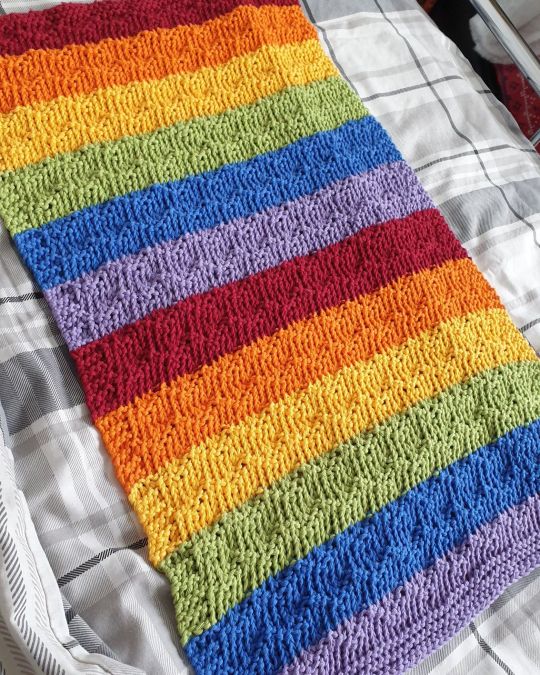
This was one of the first things I knit, the tension is fairly loose and I'd honestly like to remake it, but with that said, it's a fairly simple chevron pattern and I made it into a little hand towel that I use in the kitchen to dry my hands, it's nice having a fun bit of rainbow in an otherwise dull kitchen.
#project || chevron hand towel#my content#crafter#crafting#craft#crafts#craftblr#hand knitted#knitting#knitblr#yarn#yarnblr#hand towel#low impact#zero waste#sustainability
191 notes
·
View notes
Text
🌿Minimizing Waste as a Hearth Witch🌿

Minimizing waste saves money and the environment. With a little creativity, there are many ways you can create opportunities to reduce waste and maximize the supplies you have.
🍄 Keep your jars. If you buy something that comes in a useful container and can be reused - then reuse it. In my experience, the best reuse for plastic containers is to freeze food. Also, small bottles like Advil bottles, are EXCELLENT spell jars. However, for all types, you can use them to store food, organize drawers and closets, store spell ingredients, or even make decorations. The possibilities are nearly endless!
🍄Keep all your fruit, vegetable, and herb scraps. With some scraps and water, you can make a lovely broth. Alternatively, you can use them to make a simmer pot for a spell or simply for the scent.
🍄If you eat meat, keep the bones. Again, a great broth ingredient!
🍄Avoid paper towels whenever possible. These are super wasteful and expensive. Whenever possible, I opt to use a towel or cloth. You can recycle old textiles for rags. However, if you're feeling ambitious you can knit or crochet towels and cloths; this is a great way to use up that scrap yarn you probably have laying around! You may even choose to add a bit of knot magic to these pieces.
🍄Thrift and upcycle. This is a bit of an obvious one; but really. It's a great way to have lovely belongings while reducing waste overall and saving money. With a bit of love, many things can be new.
🍄Almost every dish can be salvaged. It happens. We mess up. But, before you throw it away, do some research on how to salvage it. Odds are, you will be able to do it!
🍄Don't throw away fruits or vegetables that are overripe or wilting. Within reason, of course, many of these fruits and vegetables can be frozen for soups, casseroles, sauces, and smoothies!
🍄Buy a reusable coffee filter and tea basket for loose tea. Really, this is a given if you are a tea or coffee lover. Disposable ones are so wasteful and the reusable ones will pay for themselves in no time.
🍄Compost if you can. Compost dirt is amazing for growing ingredients for dishes and spells. While you're at it, save your eggshells, as well.
🍄Mend your clothes, blankets, and even shoes. A little bit of love can go a long way, including increasing the life of your favorite items. You can also add flair by learning how to darn and apply patches.
🍄Learn how to remove stains from fabric. In the same vein as mending, learning how to remove stains increases the life of your clothes. Different stains require different methods of removal, but usually, it is not impossible. Failing this, learn how to dye your clothes to revamp them.
🍄Use alternative cosmetics. This is a really big topic and I will create a post about this later. But, consider doing research. There are lots of things that can be made or substituted; notably face masks, hair masks, and using coconut oil as a make-up remover.
🍄Localize your practice. Use natural herbs and ingredients found in your local environment. Create your own correspondence if needed.
🍄Collect rainwater. Unfortunately, it is no longer a great idea to drink rainwater - but use it to water plants and clean your floors. Rainwater is also a powerful spell ingredient for spells that don't require drinking or putting on your skin.
🍄Only buy what you need. This time of year more than ever it is VERY tempting to buy up cheap Halloween-themed goods. But, consider an item's long-term usefulness, if it will create clutter and disorder in your home in the future, and if there are alternatives.
🍄Buy a cheap food dehydrator. These are perfect for making tea and drying out herbs, flowers, and other ingredients for spells and cooking.
🍄Consider alternatives in cooking and spells. There is always an alternative, you may not have to buy something new.
🍄Meals and beverages as spells. As a full-blown kitchen, I believe spells eaten and drank are extremely powerful. It also saves on ingredients.
#kitchen witch#hearth witch#sustainable witch#zero waste witch#zero waste witchcraft#DIY witchcraft#spells#witchblr#witch tips#witch tip list#sustainable witchcraft#kitchen witchery#hestia#helpol
2K notes
·
View notes
Text
Fast Fashion to Slow Fashion :: a DIY guide to up-cycling and mending clothing on a budget.

For those of us living on a small income, buying from sustainable fashion brands is often out of reach. I would like to point out that *buying new but ecological garments isn't the only way to cultivate a slow fashion wardrobe*. Here are a few options for transforming *upcycling* your clothing, thus making fast fashion into slow fashion:
Mend and repair :: patch hand-me-down sweaters, fix holes in leggins from target and other department stores. By giving items a longer life, and preventing unnecessary garbage, fast fashion items become slow fashion! Here are two tutorials I have written on how to mend a torn belt loop on jeans and patch leggings.
Up-cycle clothing that doesn't suit your style :: when preparing for a trip back home and wondering how to acquire some nicer clothing for the trip a friend of mine gifted me a big bag of clothes. Almost all of them were items that we could call "fast fashion" and nearly all also had stains or rips that needed mending. By fixing and adapting these items and then going on to wear them for several years longer, I am keeping them out of the cycle of buy then trash.
Tailor items that don't fit you :: Taking in clothing is quite simple and there are lots of tutorials on how to hem pants and skirts or take in a size or two. I recently made a tutorial on how to take out a skirt, or make a skirt bigger by adding panels.

At some point, we must face the fact that a t-shirt is totally worn out and cannot be used for clothing any longer. In such cases here are a couple of crafts to utilize the fabric and other items from the scrap pile:
Create a Quilt :: if you find yourself with a pile of beautiful & memory-filled scraps -- transform them into a quilt as I have done in this post.
Make Twine :: Longer scraps of fabric, especially those from stretch materials like leggings or jersey cotton t-shirts can be made into a thing rope also known as fabric twine. I wrote a tutorial on how to make twine out of fabric scraps.

<<Best of luck in all your crafting endeavors!>>
#upcycled fashion#slow fashion#fashion tutorials#mending#mending 101#mending references#mending masterpost#cottagecrafts#upcycle#repair culture#low waste#zero waste#wasteless crafts
375 notes
·
View notes
Text
~an introduction to ecobricking~
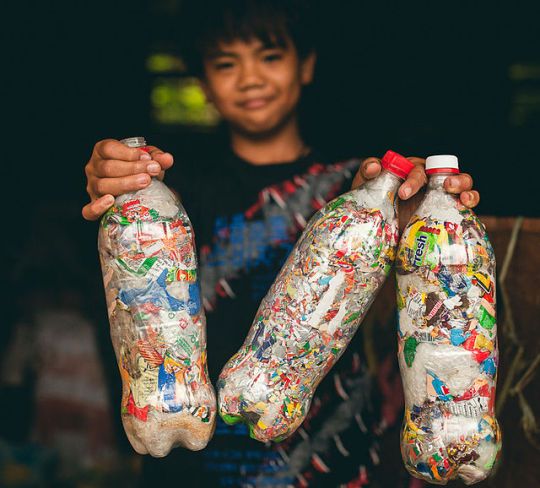
hello fellow solarpunks! i've been interested in ecobricking for a while but i recently invested some time into researching them so here's a guide! it's a responsible way to sequester plastic from the environment, but making them is slightly more involved than just stuffing plastic in a bottle, if you want to use them for construction or weight-bearing projects like furniture. I'm mainly using information from GoBrik, which had the most comprehensive guide, but feel free to comment or rb with supplemental information.
FAQ:
Isn't it better to recycle plastic rather than ecobricking?
There are many plastics, such as food wrappers or packaging, that can't be recycled and end up degrading rapidly. Ecobricking sequesters those kinds of plastics from the ecosystem and also reduces the surface area exposed, which limits plastic degredation over time.
How do you use ecobricks?
You can use ecobricks in many applications, from furniture to structures. The long-term environmental impact of using ecobricks is still speculated on, but responsible upkeep mitigates their potential environmental impacts, which are still far less than the impact that plastic would have were it not sequestered.
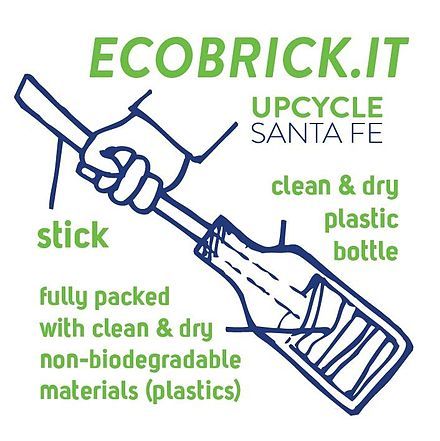
How To Ecobrick:
Find a plastic bottle. The bottles that you use for ecobricking should all be the same variety, which will help in any building projects that you may choose to use them for.
Find some plastic! Make sure to wash and dry your plastic, as any food residue or moisture could make your brick moldy or structurally unsound. You can cut up larger pieces of plastic, like food packaging (think bags of shredded cheese or frozen berries, or the plastic bags inside cereal boxes)-- just pack em in. If you want to be fancy, GoBrik recommends making the bottom layer of your ecobrick all one color, for aesthetic purposes later on. But it's really up to you. Please avoid putting biodegradable material, such as cardboard or paper, as well as glass or metal, in your ecobrick-- it'll affect the density and preferred composition. Plus, you can recycle those!
Calculate the density! This is the only part that involves math, I swear. You want to aim for a density of about 0.37 grams per milliliter; it shouldn't be under 0.33 g/ml or it'll be structurally unsound. It's also good to aim for a density less than 0.7 g/ml, or your bricks might be too heavy to move comfortably. The equation is just the weight in grams divided by the milliliters of the container you're using, so, for example, if you used a bottle than was 1250 ml, you would be aiming for about 475-500 g of plastic (including the bottle). (a kitchen scale is great for weighing, and you can thrift them pretty easily) Of course, if you're ecobricking to sequester plastic and not necessarily to build, you don't need to worry too much about the density, but if you wanted to donate your ecobricks to a project in the future I would encourage you to try to keep track of density.
Cap your bottle tightly, leaving 1-2 cm at the top of the bottle (basically, you don't want the cap to bulge, because it will make the cap degrade rapidly and crack). Label them with the density of the bottle (if it's relevant) and the date (so you know how long the brick has been around so you can maintain it if needed)-- nail polish works the best. Keep them out of the elements (especially the sun) and off the ground until you plan to use them.
There are tons of ways to use ecobricks! I'll link a few ideas below.
https://ecobricks.org/en/build.php
https://ecobricks.org/en/modules.php
anways, happy bricking! i'll post a picture of my finished ecobrick when it's done (hopefully not soon!)
Sources:
https://en.wikipedia.org/wiki/Ecobricks
https://ecobricks.org/en/how.php
86 notes
·
View notes